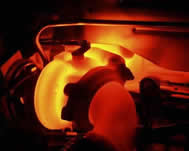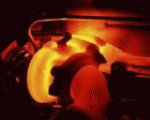
Everything posted by KATOOM
-
Pyrometers install
The plug would be found in the residential "gas" pipe section as you cant use galvanized material in residential gas piping.
-
Pyrometers install
What parts? Everything should be available at your local hardware store.
-
Pyrometers install
I believe most, if not all, anti-seize is going to be high temp. And I'd use a regular iron plug too just because of the potentials for galvanic corrosion. Probably minor but I'm just leery like that.....
-
Snubber, needle valve, or both?
I'm not sure I'd lubricate them either. They're the same material and there's no reason for binding or corrosion. The most common procedure for tightening up JIC is to get them hand tight and then turn them to the specified number or "flats" which will be determined by the size of the fitting. For -8 I think its something like hand tight and then one full turn with a wrench. You can look it up if you want but nonetheless, if the mating surfaces are matched then it wont matter how tight you get them.
-
Pyrometers install
90* degrees.....
-
Pyrometers install
Yes, they use a compression fitting to lock a collar over the thermocouple. If your fitting looks about the same size as the one Moparman pictured then its 1/8". But if it looks larger then its 1/4". Thats your only two options..... But if you're unclear which one it is then simply go pick up both tap sizes and you'll easily be able to tell as they're clearly different in size.
-
Pyrometers install
Oh I definitely think you need to be watching the back cylinders instead of the front. But.....that said, if you were so inclined you could be ultra cool and drill the other side and use one of the gauges. Dual EGT gauge
-
Pyrometers install
I dont think anyone has that information as it would require data from both ports using simultaneous gauge readings. But for their differences in temperatures..... I think they're all running very similar EGT's but because 5/6 (especially 6) have slightly choked intake ports, and by virtue of the cooling system design limiting flow across the back portion of the block, they will run a tad hotter than the forward cylinders. Taking all that into consideration, the breaking point temperature window for cylinder failure is very small so making sure you're watching what those hotter cylinders are doing is most important. As Moparman pointed out, there's a reason you read threads about the number 6 cylinder over that of other cylinders.
-
Snubber, needle valve, or both?
If you already havent, I'd call and send those pictures to Vulcan and alert them that they must have received a bad lot of those fittings because you couldnt do that with a wrench. They're steel and if you could smash the surface like that then you would be rolling the edges of everything else too. And no, they're not a one time fitting either. JIC and AN are the same thing except that AN fittings are aluminum, and usually come in pretty red and blue colors. "AN" standing for "Army/Navy" and "JIC" for "Joint Industry Council". These fittings were designed for industrial use and can take thousands of PSI. The only issue I have with them is even though they're all following the standard 37* flare, there's many manufactures and hopefully they all match up perfectly with one another. Clearly though the ones you have dont have mating surfaces.
-
Pyrometers install
You're right. Thats is in the wrong spot. It should have been drilled on the left port which measures the back three cylinders because 5 and 6 run the hottest.
-
Snubber, needle valve, or both?
Something definitely looks not right..... Where did you get these fittings? And here's a tapped 90* push-loc. http://www.vulcanperformance.com/Pushlock-1-2-X-08-FJIC-90-Deg-Tapped-p/poet8.htm
-
Pyrometers install
Take a picture of where its tapped.
-
Snubber, needle valve, or both?
If its not leaking then leave it alone. Looks fine. Pour some warm/hot water on everything (that isnt electrical) and let it dry. The hot water will wash all the residual diesel off. But then again.....I know you're going to tear it all apart.
-
Pyrometers install
I have the EV series with the amplifier box. Had it for about 10 years now. About 7 years ago I noticed a slightly low EGT reading and ISSPRO was right there to help me diagnosis the source. They ended up sending me a replacement amplifier and I replaced the thermocouple too just to be sure. They do wear out from the constant barrage of exhaust heat. The only issue ISSPRO had back then was the amplifier could make a high pitched noise but the newer ones stopped that. I mounted mine in the cab under the dash behind the kick cover in front of the drivers legs. The main important factor to understand is you CANNOT cut the thermocouple wires in order to reduce their length because everything is calibrated for all the wires at their specified lengths from ISSPRO.
-
Mountain towing
8000 is nothing for these trucks in stock form. I only have an EZ and RV275's and I can tow my 14k-15k 5th wheel pretty nicely in the mountainous northern CA. Usually able to keep it in 4th gear too.
-
Snubber, needle valve, or both?
Yes.....I know.
-
Snubber, needle valve, or both?
This isnt me telling you to tighten them more but.....just letting you know that when I installed my fuel lines some of the JIC fittings were stubborn and leaked a little. NOT dripping but more weeping. After farting around with them for awhile I finally just cranked down and they sealed up. I wont tell you how hard either because you'll think I'm crazy. Unlike aluminum or brass, they are steel and maybe just take some force to get the surfaces mated properly.
-
Snubber, needle valve, or both?
Just by virtue of JIC design, the fitting in the picture cant leak at the swivel. If the Push-loc fitting leaks where you're pointing in the picture then the JIC flare flange isnt sealing or the sealing washer is leaking. Diesel fuel is like oil and will creep around encompassing a large area instead of dripping at a specific location giving you the impression the leak is coming from a different source.
-
Snubber, needle valve, or both?
I think I popped a blood vessel in my eye trying to force those stupid things together.
-
Anyones interested for engine aluminum oil pan???
I like your ingenuity but this would be vastly over complicated. Plus there is already an oil cooler on the engine which utilizes engine coolant to warm and cool the engine oil, just like the transmission heat exchanger. So I would say if you're concerned about cold weather running with an aluminum oil pan then you could simply run a pan blanket during the winter.
-
Anyones interested for engine aluminum oil pan???
Yes, generally less heat is better for internals but engine oil running too cold is as equally damaging. Engines have to run at specified temperatures and engine oil should run at around 190* - 210* F range otherwise the oil will retain moisture from the combustion process creating acid which will eat up bearings, cause the bearings to drag from lack of lubrication, and force the rings to plow through thick oil. If your aluminum oil pan dissipates so much heat that oil temps cant maintain optimal levels then you're doing harm.....
-
Snubber, needle valve, or both?
Just looked up the Edge Comp instructions and this is what it said: Determine a good 12 volt circuit for use as a power source. Verify this circuit has power while starting and running and no power with the ignition off. NOTE: A good circuit is the number 17 fuse (10 AMP Cluster A) inside the fuse panel located on the left side of the instrument panel. Remove the fuse panel cover, and locate the number 17 fuse. Attach the supplied male fuse tap connector onto the fuse. Reinstall the stock fuse with connector back into the fuse panel (this is a very tight fit). I too connect to the cold side otherwise the Comp will receive power all the time and be non-fused. But if you're concerned about the rattling then definitely let Edge know. No point in accepting something that may have been dropped or damaged.
-
Anyones interested for engine aluminum oil pan???
I haven't monitored the engine oil temp. Do many members? Not saying its not an important variable but just curious as to who keeps an eye on those temps.
-
Snubber, needle valve, or both?
I on the other hand am leery of Teflon tape because its easy to create a leak if you ever find yourself turned too far and have to back it a 1/4 turn or so. And its easier to get shards of it in the fuel lines, which would be bad. But I guess that said, if someone is incompetently unsafe using either both thread sealant and Teflon tape, you're going to have problems. And I do agree that multiple snubbers is a good thing. I have two..... If you want to run a needle for emergencies then thats OK too.
-
Anyones interested for engine aluminum oil pan???
Hmmm..... I dont think I've ever heard of anyone having problems with the stock steel pan. Still interested to see what you create though.



